Jean Ponzi promotes environmental education for kids, business people, and the general public as program manager for the Gateway Center for Resource Efficiency, a division of the Missouri Botanical Garden.

Monday, 21 Apr 2003
ST. LOUIS, Mo.
Earth Week. In my business — environmental education — this strip on the calendar includes actual Earth Day, April 22. In just three decades of official acknowledgement, that date has sprawled, in the manner of Christmas, into a virtual season of green.
People whose interests are black and white, blue, or checkered get the urge to energize their connection with all things green around Earth Day, and the calls flood in to people like me seeking classes, speakers, tours, staffing of outreach tables at events, and activity recommendations that range from basics like recycling to affecting legislation on complicated environmental issues.
This is the most demanding period in the annual cycle of my profession. Although I’ve been known to moan and kvetch about the public tendency to cram environmental citizenship into one month or week or day in the year, I do appreciate how Earth Day has popularized subjects I believe can usefully green most fields of endeavor. And at the rate humankind is going, I certainly have job security — as long as I keep writing grants!
Martha Stewart’s Christmas pales in comparison to some of my Earth Days, but the schedule for this week is only moderately intensive, even with events on all seven days. I’ll be teaching at a middle school Earth Day celebration (six sessions, 350 kids), meeting with state legislators and regulatory officials during a citizen lobby day, preparing for two big weekend festivals, broadcasting the 15th-anniversary edition of my weekly environmental radio talk show, and responding to various last-minute requests that are sure to come before this verdant month is over.
I am one of two managers of the Gateway Center for Resource Efficiency, a division of Missouri Botanical Garden. We specialize in environmental education in the topical areas of energy efficiency, recycling and waste reduction, green building, and related practical applications of sustainability. We’ve been in this business since 1988, I joined the team in ’95, and we became part of the Garden in 2000. My job still includes some actual teaching, but much less than in earlier years. I give plenty of public presentations, take care of a lot of our division’s outreach writing, and do much of our grant-writing and development research. In between the cracks of these main responsibilities, I try to keep up with the low maintenance needs of our building’s native plant garden, working with one volunteer Master Gardener who is a most precious resource.
I use the term “business” to describe Gateway Center because we strive to balance the input and output of what we do, including our personal energies, money, and the mission we serve. We are a nonprofit operation, part of a major regional cultural institution with an international reputation, and we work hard at modeling and promoting applied ecological principles that can truly green both practice and profits. Deborah Chollet, our division’s director and my friend, has a business and engineering background. I’ve learned a lot from her about focused, effective nonprofit management, and about giving others the benefit of the doubt.

Visitors tour the EarthWays Home.
Photo: Dale Dufer.
This morning Deb and I gave an informal tour of our headquarters, the EarthWays Home, which is one of a number of satellite sites of Missouri Botanical Garden’s main campus. We work in a three-story Victorian house that was built in 1885 and renovated in 1994 to demonstrate energy and resource efficiency in a residential context. The idea is that anybody of any age, who does any kind of job, can identify with and adopt into their lives examples of sustainability “at home.” The house is one of a handful of green buildings in the St. Louis region, and it’s a major tool for communicating our resource conservation message.
Our guests were new colleagues, staff of the Botanical Society of America, which recently affiliated with Missouri Botanical Garden and moved its operation to St. Louis. We chatted about our respective purposes, theirs being promoting botany and botanical advances, with a growing emphasis on reaching student populations. It’s gratifying when staff of other parts of the Garden take the time to learn about our work and our facility, especially because our subject matter may not initially seem to be connected with plants.
One of my favorite things about working for the Garden is interaction with fellow employees. The level of discourse is intelligent, good-humored, witty, and vivid with expertise in many scientific and professional disciplines. Collegial relations are a delightfully stimulating benefit of my job, whether the subject is a researcher’s latest taxonomic travels, a horticulturist’s fond knowledge of pond ecosystems, or the HVAC guy’s personal interest in and skill with photovoltaics.
I enjoy learning from my coworkers, and sharing what I know about greening the human-built environment. Being part of an institution that is dedicated to conservation and environmental education, I feel encouraged and supported in this work of problem-solving insoluble problems. I get to know a lot of people for whom Earth Day is every day, and when my spirit needs a break, I can take a walk in the Garden.
Tuesday, 22 Apr 2003
ST. LOUIS, Mo.
Happy Earth Day! I feel really privileged to be writing for Grist this week, prime time for the human attention-span to focus on environmental issues.
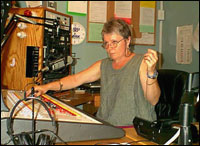
Countdown to airtime on KDHX Earthworms.
Photo: Thomas Ball.
Today is an anniversary for me, as well. Earth Day marks (approximately) the start of my longest-running job, as producer and host of “Earthworms,” an environmental radio show. I started it 15 years ago, and I do it on a volunteer basis. “Earthworms” is a weekly, hour-long, interview-format talk show, an original feature of the public-affairs programming on KDHX-FM, St. Louis Community Radio.
KDHX is one of about 30 independent community radio stations remaining in this country; when I first got involved there were more than 100. With 47,000 watts and an 80-mile broadcast radius, we are a powerful station in a major media market. We are primarily a music station with about 150 volunteer programmers bringing their passions and expertise to the airwaves.
We reach urban, suburban, and rural listeners in 25 Missouri and 15 Illinois counties with commercial-free, totally unfettered creativity. This is an incredible resource for the St. Louis region, especially considering almost all the broadcast media in the world is now owned by about a dozen companies. KDHX is rare, but it is not an endangered species! Listener memberships generate about 65 percent of our operating revenue, and the contributions keep increasing. We just had our spring pledge drive, which started the same day as the war; it was precarious, unsettling timing but the calls and pledges never faltered.
“Earthworms” is a solo project. It’s easiest and most satisfying to coordinate the logistics of booking guests, researching topics and running the show on my own. I did have a regular contributor for a couple of years — a woodworker, artist, and musician who was active in the Sierra Club. He wrote and read wonderful short prose pieces called “The Wild Skies Weather Report.” Aside from that, it’s the worms and me.
The show’s name was a fortunate accident. The early editions had no topical focus until a friend suggested I cover environmental issues. I polled the audience about this change and solicited their ideas for a title. Callers were overwhelmingly positive about the idea, but the names they proposed were universally dorky. (“Wisdom of the Mother,” for example, and “Gaia Triumphs.”) Then a guy suggested “Earth Words” — but I thought he said worms. Years later, at a party, I met the man who conferred upon me an annelid-ical totemic identity, and I got to thank him.
“Earthworms” is not officially a part of my job, although Gateway Center’s director generously supports my work on it, and the business often benefits from my interview contacts. The show keeps me abreast of a broad range of complex environmental issues that I wouldn’t otherwise be ambitious enough to track, and this diversity in turn balances the focus on recycling and resource-efficiency I need to maintain for Gateway Center.
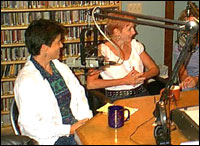
A good host puts her guests at ease.
Photo: Thomas Ball.
Many of my interviews now come to “Earthworms” through the Mainstream Media Project, based in northern California. MMP assembles rosters of experts to address broadly defined topics, pitches these subjects mainly to commercial radio stations, and books the guests with fabulous email efficiency. Halimah Collingwood, my contact at MMP, has become a true friend, although we’ve never met.
“Earthworms” serves a local audience, including many guests and topics from the St. Louis region, but Mainstream Media has linked KDHX listeners and me to the world. For example, this spring through MMP I interviewed Frances Moore Lappe about her new book Hope’s Edge: The Next Diet for a Small Planet; Scott Cassel, founder of the Product Stewardship Initiative; and Robert Gould, president of Physicians for Social Responsibility.
Tonight’s show wraps up a series of interviews promoting the wealth of Earth Day events around St. Louis. I try to include a lot of local Earth Day spokespeople on my April shows, and I have to crank up my coordinating efforts to get in as many as four or five guests and segments in an hour show. This year, Earth Day overlaps with an international conference on Biodevastation being sponsored locally by the Greens, and a personal desire to focus some airtime on peace issues.
The pace will ease up a little in May, and I’m already getting requests for interviews in July and August. I’m glad to be of service. Hosting a talk show is a great job. My guests bring the information, and all I have to do is ask good questions and carry on the conversation. Because the environment essentially includes everything, I can deal with almost any issue that matters to me. I mostly stick to classical environmental topics, but when worms take the microphone on a Tuesday night, any subject can turn green.
Wednesday, 23 Apr 2003
ST. LOUIS, Mo.
One of the major Earth Day events held here in the Confluence Watershed was the fourth annual water symposium, which addressed connections between environmental, social, and economic concerns. I heard some excellent presentations and led a panel session that was something of a donnybrook.
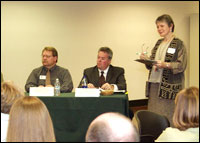
The calm before the storm of complexity at the watershed symposium panel.
Photo: Dale Dufer.
“Clean Water, Livable Cities: Models that Work” was coordinated by St. Louis Earth Day. The roughly 200 participants included municipal officials from Missouri and Illinois communities, state and federal agency big dogs, property and economic developers, environmental activists, and academics. I knew people there who work in soil and water conservation, green building, regional planning, hydrological engineering, community organizing, and many other fields. It was a great turnout, in diversity of fields and interests.
St. Louis is the built-environment heart of the most water-rich region in this country. Our watershed encompasses the confluence of the Mississippi, Illinois, Missouri, and Ohio Rivers, hundreds of smaller rivers, and thousands of feeder streams. It drains one-third of the North American continent. Water shortage isn’t currently one of our problems, but the full boat of aquatic issues is firmly anchored here. We deal with flooding, erosion, sedimentation, water quality woes, gaps in water treatment infrastructure, and West Nile Virus.
We also have some excellent models. For example, the Meramec River, a beloved Ozark float stream which flows into St. Louis, was once one of the nation’s most polluted and now ranks in the top 1 percent nationally for biodiversity in an urban river. Missouri’s Operation Clean Stream has modeled volunteer water-monitoring and cleanup methods for the whole country for 35 years. And this year marks the 25th anniversary of a stunning victory for nature over buildup: the defeat by citizen activists of the Army Corps of Engineers’ Meramec Dam.
On the other hand, in 1993 and again in 1995, our big rivers flooded to 500-year levels, which means flooding that never happens more than every half-millennium. Tax dollars, on top of Federal Emergency Management Agency buyouts, have since funded construction of 1,000-year levies to protect new malls and parking lots that continue to sprawl across the Missouri River floodplain.
The keynote speaker at yesterday’s symposium was Bruce Ferguson, a landscape architect from the University of Georgia who is the definitive green authority on stormwater. His work has built a (pervious surface) foundation for integrating urban watershed development with natural processes. He showed slides of engineering features that look like artworks and function like — natural systems! And the water-management methods he cited cost consistently less than “traditional” technology and materials.
Ferguson talked about urban watershed restoration in terms of enhancing quality of life and assuming that whatever is physically possible is institutionally possible as well. His approach was refreshingly different from that of the expert who comes in and tells a community how things will be done for its own good, the natural world be damned. Not to mention dammed. He’s staying in town another day to conduct a technical seminar and registration is full. How hopeful that local specialists in many fields are eager to learn from an innovator like Bruce Ferguson, who so passionately respects and understands the workings of natural systems.
My panel included nine professionals who deal with water, economic, and regulatory issues. We discussed a fictional municipal scenario fraught with complications about municipal stream-protection ordinances, a lucrative housing development proposed for the only area of the town with a pristine stream, potential jobs and tax revenue, citizen opposition, and roadway and bridge expansions. Panel members had studied the scenario and the batch of issues, but only I had a list of several knotty questions related to each issue. My job as moderator was to guide discussion through each issue and throw out the secret questions to particular individuals, the whole group, and the audience. The situation grew into lifelike complexity in two rollicking hours. Being a talk show host, this was big fun for me.
The water symposium was held at the Missouri Botanical Garden, so after the meetings, I got to celebrate Earth Day with a fragrant, color-saturated, late-afternoon stroll with my husband, Dale. We got together during Earth Day 1990, when I was coordinating one of the largest environmental events in St. Louis history and he electrified my festival — but that’s another story.
My 15-year edition of “Earthworms” was packed with double the number of interviews and action items I usually schedule in that hour of radio, plus a couple of songs and the required underwriting announcements and arts and concert calendars. I’m not sure how I got it all in, but the show ran smoothly, and I felt so happy! Radio is so much fun, the milestones and energy of this week are a big charge, and it was Earth Day!
I will draw on the joy and vitality of this week’s activities when I come again to the bottom of the cycle that defines my work for the environment. I know I’ll need a shot of positive attitude at that point to keep me going, but right now I am centered, happy, and working hard.
Next stop: Jefferson City for Environmental Lobby Day.
Thursday, 24 Apr 2003
ST. LOUIS, Mo.
Creeks and highway skip along together, voluptuously curved. The view goes deep into the hazy green of an oak-hickory understory, where drifted banks of dogwood sparkle in the morning sunshine. I know we’re in a flood plain when forested turns suddenly stretch into vistas — and, sure enough, we cross a river. I love being able to read a landscape, and Missouri in the spring is the Great American Novel.
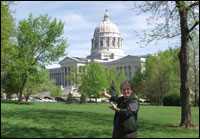
At the Show Me State capitol.
Photo: Dale Dufer.
The trip to Jefferson City feels like a pleasure cruise but it has a serious purpose: educating state legislators and urging them to vote green. Less than a month from the end of their session, a tangle of bills rivals the current federal trend in heedless pollutocracy. (Thanks, Umbra!)
“A Day for Conservation” continues an Earth Day tradition set by the Missouri Coalition for the Environment, a stalwart guardian of the state’s natural resources since 1969. The Sierra Club Ozark Chapter, with five active regional groups, is also a major contributor.
Today’s citizen lobby has been organized by a newly launched Missouri Coalition project that is already a powerhouse, Missouri Votes Conservation. Even in this anti-environmental climate, MVC is clearly making progress by building relationships among elected and activist partners, and through a consistent, positive presence in the capitol.
MVC’s strategy of educating legislators about environmental issues, mobilizing citizen involvement, and holding lawmakers accountable with a well-publicized voting scorecard was implemented at a pivotal time. Voter-initiated term limits kicked in during our last two state office elections, so this General Assembly is a freshmen class and the first Republican majority in 52 years is running Missouri’s House and Senate.
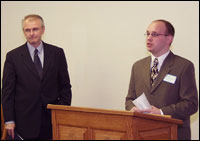
Missouri Votes Conservation’s Josh Campbell introduces Governor Bob Holden (D).
Photo: Dale Dufer.
Josh Campbell, political coordinator of MVC, is a calm, pleasant, extraordinarily well-spoken young man, at home in the miasma of politics. I’ve been impressed during radio interviews by his manner, perspective, and fluency with the issues. Seeing Josh in action gives me hope for the future of environmental politics, in Missouri or wherever he works.
The day’s agenda makes excellent use of the time and energy of 76 participants from all around the state. We are a mix of concerned individuals and representatives of 26 diverse organizations, from the Missouri Rural Crisis Center to the Ozark Fly Fishers. Most of these people have done citizen lobbying before. A concise orientation gets everybody up to speed on the most pressing issues and effective ways to address them with legislators.
We review several pages of summarized bills with environmental content, most of which MVC opposes. Some are not moving and will likely die, at least for now. “No Stricter Than Federal” is a weed we’ve been yanking annually, grown to invasion force in this session. Our main focus, though, is an omnibus Senate bill now on the House calendar. In its much-amended travels, this bill has become a convoluted “Christmas tree” packed with degradation potential. An afternoon buzz that it will be debated today sends us out in teams to cover the entire list of representatives. Turns out to be a false alarm, but we spoke in person to more House members than we would have reached without the flurry.
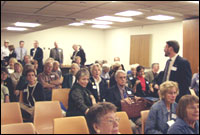
Environmental champions prepare to meet lawmakers.
Photo: Dale Dufer.
Josh has arranged for a steady rotation of environmental champions from the Senate and House to address our group during lunch. Records of action speak eloquently for these men and women, and their (thankfully limited) rhetoric is pretty entertaining. One representative asks us for guidance with a particularly emotional, values-laden conservation-agency budget issue, and she attends seriously to the responses. Several express how much they are encouraged by our coming today, and how they rely on the work and expertise of activists. I know two of these leaders personally, and I feel the anxiety and courage in their rueful jokes about life in the minority.
A freshman Republican with a 17-month-old daughter says he wants to learn about the environmental impacts of the laws he’s juggling. He urges us not to write off members of his party and suggests a list of colleagues to contact. Governor Bob Holden (D) comes in briefly to speak. I’m impressed by the quality of his interaction with Josh Campbell. The governor’s staff has met with MVC staff twice weekly throughout this legislative session. Every naturalist knows the value of a niche.
A member of Republicans for Environmental Protection from Kansas City stands in the back to introduce himself, calling on the St. Louis contingent to do the same. A man in front of me raises his hand. “One person?” laments the KC conservative, and the other guy holds up two fingers — it’s himself and his wife. A murmur through the room notes an organizing opportunity.
Interacting with veteran and rookie lawmakers from various parts of the state and both sides of the party aisle, I reflect on this whole civic exchange. Person-to-person is a reality in local and state government. Heck, the professional lobbyists I observe call legislators by their first names. I’m an expert in some environmental topics, well-versed in others, and I have something useful to offer. I’m willing to listen and converse, and I vote. This all takes time, but reciprocity is possible. And the times when lawmakers won’t listen are the times when it’s most crucial to keep up communication.
Friday, 25 Apr 2003
ST. LOUIS, Mo.
Question: What’s longer than a classroom, loud, kinetic, and involves humongous resources?
Answer: the Energy Chain, a tried-and-true element of the Gateway Center’s bag of tricks for teaching kids about the environment and sustainability. People get physically and emotionally involved in this educational exercise, acting out the energy embodied in creating, using, and disposing of one single-use plastic bottle. Natural, capital, and human resources are consumed in mass quantities as I tell a story that starts with the death of a Paleozoic-era tree, includes the gush of Saudi oil wells and the engine hum of a multitude of petroleum-guzzling vehicles, and never fails to raise a gasp from my audience when the end user blithely tosses her energy-packed empty away.

A teachable moment at the EarthWays Home pond.
Photo: Dale Dufer.
I used the Energy Chain exercise today in a huge suburban middle school, splitting the sixth grade with my colleague Chris Kalter, who kindly took the early sessions. We have two more of these massive teaching days scheduled for next week, typical of school requests around Earth Day. Between school gigs, festivals, and tours of our building, the EarthWays Home, the Gateway Center team will interact directly with a couple of thousand kids just around Earth Day.
Through Leadership in Environmental Action Projects, our longest-running program, we are able to teach lessons year-round on recycling and resource conservation with no charge to any school in the St. Louis area. LEAP is supported by grants from the St. Louis-Jefferson Solid Waste Management District. We’re literally investing landfill tipping fees into waste-reduction habits.
Environmental education yields exceptional payback on such investments. Young people blossom as they experience their own power to make a difference. The kids who first participated in Energy Chain and our other activities are about 25 years old now. When I talk with college students and young professionals, my energy for this work is renewed. Cyclical, whole-system thinking is integral to the worldview of many young people. I’m optimistic about the leadership abilities and styles of upcoming generations, although I know there’s much more work to do.
I enjoy teaching, although I don’t often get into schools these days. My contributions to the Gateway Center have evolved into formulating projects and writing the grants needed to support them. Being by nature a relentless self-promoter, it’s good karma for me to channel that bent into promoting my team’s efforts using my writing and media skills. They do send me out when it’s time to work a crowd, though, so I’ll be at Earth Day festivals all weekend.
Public environmental education is a new service for the Gateway Center. For years, our funding supported only K-12 programs; our adult audience was limited to teachers. When we became a division of the Missouri Botanical Garden and moved into the EarthWays Home, we took on the operation of a visitor facility. This is the first Earth Day when public festival outreach makes sense for us.
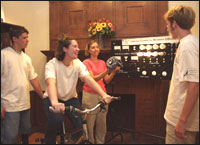
Testing the Energy Bike before its festival marathon.
Photo: Dale Dufer.
People learn best through hands-on activities, so we’ll be bringing the Energy Bike, our best hands-on (and feet-on) tool, to this weekend’s events. Each rider becomes a power plant, giving their breathless all to illuminating a row of incandescent light bulbs, followed by a row of comparable compact fluorescent bulbs. The benefits of energy efficiency are communicated as a physical reality, augmented by the demonstrator’s spiel about conserving your money and everyone’s resources. One phenomenon of the Energy Bike is that kids and adults will stand in line — for a long time — for their turn to ride it. They see what’s going to happen, over and over, and it’s always the same, but people want that experience personally. Will you be the one to triumph over four dim little incandescents? Everybody wins with energy efficiency!
Saturday we’ll be at the Garden, where Earth Share of Missouri member organizations will provide activities and displays. From its roots as Missouri Environmental Fund, this workplace-giving cooperative has joined forces with the national nonprofit Earthshare to develop funding for environmental groups throughout our state, contributing also to the national members. It’s a good example of green economics.
On Sunday, the biggest St. Louis Earth Day Festival will be held in Forest Park, our city’s crown jewel of urban green space. This is one time when the park benefits from crowds. Tree planting, prairie and glade improvement, and a stream cleanup will add to a major restoration already underway in the park.

All Species Parade dress rehearsal.
Photo: Dale Dufer.
New (young!) coordinators have brought connections in the St. Louis art community and fresh energy to this festival. I coordinated Earth Day 1990 and a lot of the same people who worked with me remained as the volunteer core for years. I’m so pleased there’s new leadership, enabling us older farts to play less demanding roles and enjoy the festival’s growth and continuity. A friend and contemporary recently informed me, “Fifty is the new thirty!” So I guess I can plan on a couple more decades of my current activity level.
When I manage to escape from my office, I like to get involved in extravaganzas. Earth Day provides an opportunity for this in the form of the All Species Parade. At noon on Sunday, the Saint Louis Zoo will unleash a procession in homage to biodiversity, with human creative license. I have more work to do on my parade regalia, but the main part is ready. It was rescued from a high school dumpster. The useful things people throw away!
Environmental work in this era is hard, so I feel it’s all the more deserving of celebration. May the spirit of Earth Day renew your courage, and leave you laughing.

